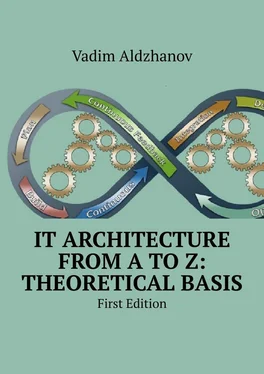1 ...8 9 10 12 13 14 ...27 Benefits: Relatively low operative expenditures of IT infrastructure.
Deficiencies: Relatively high capital expenditure of IT infrastructure.
Distributed Data Storage System (DDS, SDS)” implies that the data is distributed between different physical servers. A storage system is a complex distributed within the network and consisting of data controllers and disk storages.
Recommendations for selection:
“Physical servers” solution is more preferable for small, isolated or remote IT services, or high volume systems. For all other cases, it is better to use a virtualization platform.
Strategy of choosing the manufacturer
The strategy for choosing software and hardware determines the approach to the choice of manufacturer, standardization, and so on.
The following options can be considered:
• Use of a limited list of manufacturers;
• Use random list of manufacturers.
Using a specific manufacturer for each category of IT assets implies using hardware and software standards within the organization.
Benefits:
• Implementing IT asset standards simplifies providing an organization staff with IT assets;
• It facilitates the implementation and maintenance of IT infrastructure, and increases the level of the organization’s information security.
Deficiencies: Relatively high cost and dependence on the manufacturer/supplier.
Using a random manufacturer implies use of recommendations instead of hardware and software standards within the organization.
Benefits: Relatively low cost and promptness in procurement of IT assets.
Deficiencies:
• The process of providing an organization staff with IT assets is more sophisticated and takes longer;
• It complicates the implementation and maintenance of IT infrastructure, and
• reduces the level of the organization’s information security.
Recommendations for selection:
The first licensing option is recommended is recommended to organizations with close integration and dependence of business and Information Technology or a large number of employees.
Licensing strategy
The licensing strategy determines the approach to licensing methods. The following options can be considered:
Using an “Enterprise” license agreement with the annual software update. Licensing is an ongoing IT process.
Benefits:
• Greater flexibility of licensing.
• Maintaining the high level of IT infrastructure and information security due to using updated versions of systems and solutions.
• Systems are upgraded smoothly, with no surges in requirements of IT, human resources or time.
Deficiencies: Relatively high cost.
Purchasing commercial off-the-shell retail versions with no software update. Licensing “upon request”.
Benefits: A relatively cheaper option.
Deficiencies:
• Less freedom in licensing.
• The level of maintaining IT infrastructure and information security is reduced due to using not the most updated versions of systems and solutions.
• Systems are upgraded in jumps (every three, four years), and require additional IT resources, people, and time.
Recommendations for selection:
The first licensing option is recommended to organizations with close integration and dependence of business and Information Technologies.
The strategy of building engineering systems
“On premise” and “Hybrid” solutions demand to determine the engineering system requirements. The engineering systems requirements for may include:
• Physical requirements for the premises of the data center, server room, data cabinets etc.
• Requirements for a Structured Cabling System (SCS).
• Requirements for redundancy, reservation and so on.
Testing strategy
Testing is one of the important elements when building an IT architecture. Testing questions have to be identified at the design stage. There are the following platforms:
•“Test or Development” is a platform with individual IT services deployed which is used to develop services or adjust IT service elements.
•“Pre-production” is a smaller “Production” platform containing all the components of the IT architecture. It is used to test the interaction of IT services and allows emulating troubleshooting, estimating performance, and so on.
•“Production” is a platform with detailed computing resources providing IT services.
Recommendations for selection:
Various solutions can be implemented depending on the business requirements and the organization’s financial capacity. A detailed description is further discussed in this guide.
Redundancy strategy
Defining the redundancy level of IT infrastructure components indicates the requirements for duplication of components. It can be reviewed as follows:
• Components of engineering systems (channels and communication cables, switching racks, etc.). Reservations (duplication or redundancy) at the level of critical elements, such as:
• Channels and communication cables (two or more in different stacks),
• Excessive number of operating points (ensures the organization growth and backup).
• Device components (server, switch, and so on). Duplication at the level of critical elements such as:
•Processors (two or more),
• RAM (two or more),
• HDD (two RAID1hard drives + one backup)
• Network cards and adapters (two cards with one or more ports)
• Power supply units (N+N or N+1)
• IT service components. Backup at the device level and the type of their inclusion. For example:
• Two servers in a failover cluster
• Two servers performing the same function (two domain controllers)
• Two servers performing different functions in the normal mode, but can assume the neighboring function in the case of a failure (File server and print server. In case of failure, one can install the function on a neighboring server).
• Geographically separated devices within the site. Allocating a pair of devices in different racks, rooms, or buildings within the same site.
• Geographically separated devices at the site level. The allocation of a pair of devices on different sites.
Determining the backup level depends on the business criticality of failure or downtime. It is analyzed within Risk Management, formalized in documents on equipment standards.
Backup and Archiving Strategy
Backup systems and archiving IT infrastructure may define the following requirements:
• System components must be installed on dedicated physical elements (servers, storage, and so on)
• Backup and archiving systems on the same components can be combined.
• Access rights to (automatic) backup accounts should not provide an opportunity to delete data or overwrite them.
Backup building strategy
Backup component is one of the important elements when building an IT architecture. It relates to the information security, fault tolerance and recovery. The fault tolerance can be as follows:
• Fault tolerance at component redundancy level;
• Fault tolerance at the level of duplicating elements;
• Fault tolerance within the site;
• Fault tolerance with geographically distributed site.
Approaches for Enterprise Architecture Implementation
When designing company’s architecture, one should not start with developing a strategic architecture. The “Top-Down” approach (Strategic Architecture Segment Architecture Solution Architecture) is certainly the most widely spread and has many benefits:
Читать дальше












